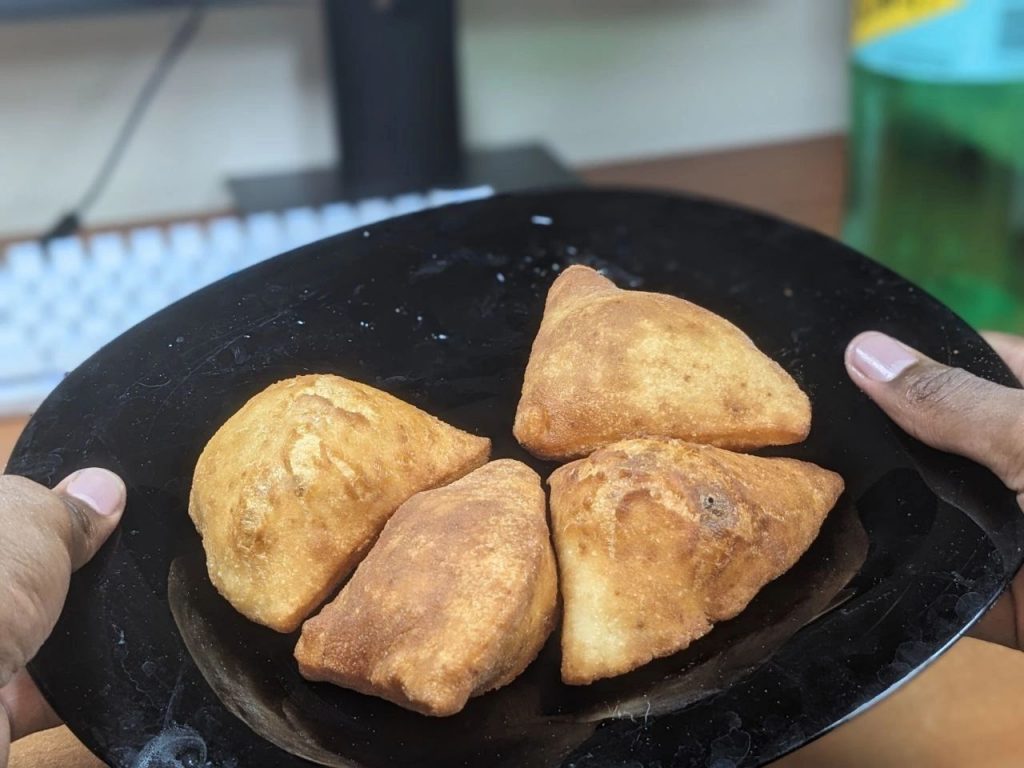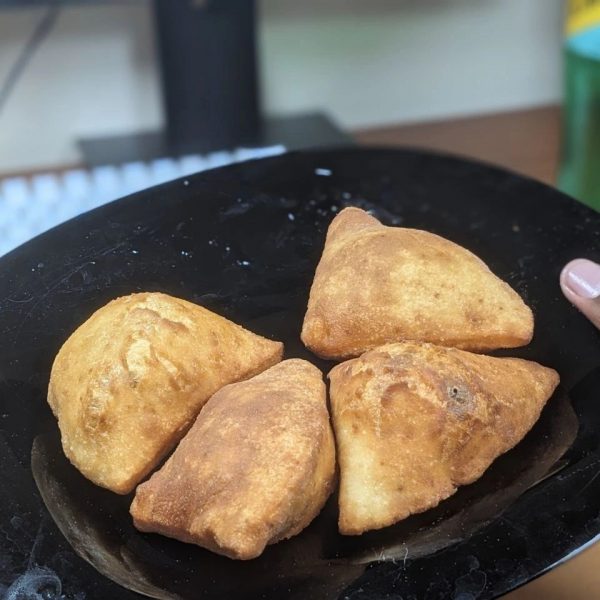Mandazi, a popular East African donut, is typically light, fluffy, and slightly sweet. This beginner-friendly recipe simplifies the process, omitting milk and eggs without compromising on the delightful taste and texture that Mandazi is known for. Perfect for vegan diets or those with allergies!

Mandazi is often confused with Mahamri, which is almost the same exact thing except it uses yeast as a raising agent while mandazi uses baking powder
Read More: Authentic Mahamri Recipe: With Cardamom
Also Read: Mandazi vs Mahamri: What is the Difference?
Ingredients
- 2 cups all-purpose flour
- ½ cup sugar
- 1 tsp baking powder
- ½ tsp salt
- 1 tsp ground cardamom (optional, for flavor)
- 2 tsp margarine or butter(optional, for smoothness)
- ¾ cup warm water (adjust as needed)
- Vegetable oil, for deep frying
- Optional: powdered sugar for topping
I’ve found that Soko All Purpose Flour gives the best results for making mandazi, and I recommend using Rina vegetable oil for frying.
I’m not affiliated with these brands; they’re just my personal favorites based on my own experiences.
Check other equally good brands here:
Grocery Guide: The 10 Best Wheat Flour Brands in Kenya
Grocery Guide: The 10 Best Cooking Oils in Kenya
You can omit the optional ingredients initially, and once you become more skilled, you can begin to include them to enhance the results further.
For this recipe, none of the optional ingredients were used
Instructions
- Mix Dry Ingredients: In a large mixing bowl, combine the flour, sugar, baking powder, salt, and ground cardamom. Stir these together until they are well mixed. Personally, I prefer dissolving dry ingredients that are not flour separately in a container till well-mixed
- Add Butter or Margarine: Scoop the melted butter or margarine into the dry ingredients. Use your fingers or a fork to blend it in until the mixture looks like coarse crumbs. (Optional Step)
- Add Water and Form Dough: Gradually add the warm water to your dry ingredients. Start with about half a cup, mixing it in thoroughly, then continue adding more until the dough comes together. You’re aiming for a non-sticky dough. Knead it in the bowl for about 5 minutes. Notice that the dough here is not that soft as compared to chapati, but more on the denser and stiffer side.

- Rest the Dough: Cover the dough with a damp cloth or a cling film and let it rest for at least 30 minutes. This resting period helps the dough relax and makes it easier to shape, and the covering is to prevent dehydration of the dough.
- Roll and Cut: After resting, turn the dough out onto a lightly floured surface. Roll it out to about ½ inch thickness. If you love your mandazis hollow and puffy then make the thickness ¼ inch like I did here. Use a knife or dough cutter to cut the dough into triangles or any shape you prefer.

- Heat the Oil: While you’re cutting the dough, heat the vegetable oil in a deep fryer or large, deep skillet or sufuria to 350°F (175°C). You’ll want enough oil to deep fry the Mandazi, typically a few inches. or at least 1/4 full in the sufuria(pot)
- Fry the Mandazi: Carefully place the dough pieces into the hot oil. Do not overcrowd the pan; work in batches if necessary. Fry each piece for about 2-3 minutes on each side or until they puff up and turn golden brown.

- Drain and Serve: Remove the Mandazi from the oil and drain them on paper towels. If desired, while still warm, sprinkle powdered sugar or coconut flakes on top for an extra touch of sweetness, (again optional)
- Enjoy: Serve your homemade Mandazi warm or at room temperature as a delicious snack or pair it with hot beverages.

Notes & Tips

- For a different flavor, you can add a pinch of cinnamon or nutmeg to the dough, personally, I love cinnamon on mandazi more.
- Ensure the oil is hot enough before frying; otherwise, the Mandazi may absorb too much oil and become greasy, and won’t rise or puff resulting in a soggy monstrosity. Also, ensure the oil is not too hot as your mandazi will burn before actually cooking through.
- Mandazi is best enjoyed fresh but can be stored in an airtight container for a couple of days, up to 2 days tho it dries out with time.
This simple, versatile recipe is a fantastic introduction to the delightful world of African cuisine, suitable for all kinds of dietary needs. Enjoy your cooking and the delicious results!

Basic Mandazis
Equipment
- Rolling Pin
- Deep Pot / Fryer
Ingredients
- 2 cups All Purpose Flour
- 1/2 cup Sugar
- 1 tsp Baking Powder
- 1/2 tsp Salt
- 1 tsp Cardamon Ground (Optional)
- 2 tsp Margarine (Optional)
- 3/4 cup Water Warm
- 500 ml Vegetable Oil
Instructions
- Mix Dry Ingredients
- Add Butter or Margarine
- Add Water and Form a Dough
- Rest the Dough
- Roll and Cut
- Heat the Oil
- Fry the Mandazi
- Drain and Serve
Notes
- For a different flavor, you can add a pinch of cinnamon or nutmeg to the dough, personally, I love cinnamon on mandazi more.
- Ensure the oil is hot enough before frying; otherwise, the Mandazi may absorb too much oil and become greasy, and won’t rise or puff resulting in a soggy monstrosity. Also, ensure the oil is not too hot as your mandazi will burn before actually cooking through.
- Mandazi is best enjoyed fresh but can be stored in an airtight container for a couple of days, up to 2 days tho it dries out with time.
What is Mandazi in English
Mandazi is an East African version of the conventional fried donut except it doesn’t have a hole in the middle
What Does Mandazi Taste Like?
The taste of mandazi can vary depending on the recipe and ingredients used, but it’s often mildly sweet with a hint of coconut flavor if coconut milk, lemon zest, or cinnamon is used. The texture is soft slightly chewy and fluffy on the inside, with a crisp exterior from frying.
Can Mandazi Cause Weight Gain?
Like many fried foods that are high in carbohydrates and fat, consuming mandazi in excess could contribute to weight gain. However, enjoying them in moderation as part of a balanced diet should not be a significant concern
What is Mandazi Flour Made Of?
Mandazi flour is all-purpose flour from wheat but with baking powder preadded to it making it more convenient than measuring in baking powder by yourself
How to Make Soft Mandazi without Eggs and Milk
Eggs and Milk are what softens mandazis, opting them out leads to slightly harder mandazi, if you do not have milk or eggs you can use margarine, and if you do not have margarine, add some tablespoons of vegetable oil to the flour while making the dough
Can You Cook Mandazi without Baking Powder?
While baking powder is commonly used to help leaven mandazi dough, you can make mandazi without it by using yeast as a leavening agent instead. However, this may result in a slightly different texture and flavor, more like mahamris
What Happens if You Skip Baking Powder
If you skip baking powder in a mandazi recipe, the dough may not rise as much, resulting in a denser texture. However, if yeast is used in the recipe, it will still help the dough to rise, although the process may take longer.
Can you use bicarbonate of soda instead?
Yes, you can use bicarbonate of soda (baking soda) instead of baking powder in mandazi recipes, but you may need to adjust the quantities as baking soda is more potent. Generally, you would use about 1/4 teaspoon of baking soda for every 1 teaspoon of baking powder.
How Much Baking Powder for 2Kg Flour
The amount of baking powder needed for 2kg of flour can vary depending on the recipe, but a typical guideline is around 2-3 tablespoons of baking powder for every 1kg of flour.
Can I Keep Mandazi Dough Overnight?
Yes, you can keep mandazi dough overnight by covering it tightly with plastic wrap or placing it in an airtight container and storing it in the refrigerator. This will slow down the fermentation process and allow you to fry the mandazi the next day, otherwise, it will overrise and result to an intense fermented flavor
What Makes Mandazi Hard?
Several factors can make mandazi hard, including overworking the dough, not allowing it to rise properly, or frying at the wrong temperature or for too long.
Another thing is using lots of flour, before frying your mandazis ensure the dough is soft and free from excess flour on the surface
What Softens Mandazi?
To soften mandazi that has become hard, you can gently reheat it in the microwave or oven, or steam it for a few minutes until it becomes soft and pliable again.
Also, you can try using cooking oil on the working board instead of dusting flour which might lead to excess and thus hard mandazis
How to Store Mandazi
To store mandazi, allow them to cool completely, then place them in an airtight container or resealable plastic bag. They can be stored at room temperature for up to a few days.
Can You Put Mandazi in the Fridge?
While you can put mandazi in the fridge to extend their shelf life, they may become slightly stale more quickly due to the cold temperature. It’s best to store them at room temperature if you plan to consume them within a few days, 3 days at most
What is the Shelf Life of Mandazi?
The shelf life of mandazi can vary depending on factors such as how they are stored and the ingredients used, but typically they can last for 2-3 days at room temperature and slightly longer if stored in the refrigerator.
However note that the quality degrades over time, while they can be good on day three they won’t be as good as when freshly made
What is the Difference Between Mandazi and Mahamri
Mandazi and mahamri are both East African fried bread snacks, but there are some differences between them. Mandazi is usually made with plain flour and is often less sweet, while mahamri is typically made with a combination of plain and coconut flour and is sweeter in taste.
Additionally, mahamri often contains coconut milk or grated coconut for added flavor, while mandazi may or may not include these ingredients
Related to “Mandazi”
Sweet & Soft Mandazi Bites Recipe: Bite-Sized
3 Ingredients Flaky Layered Chapati: East Africa’s Flatbread.
The 17 Popular Kenyan Food Dishes
Fun Articles
Judging the 8 Most Hated Kenyan Foods
Site Navigation
Is this content useful? I mean you’re here;
Consider checking out more of my articles from the following categories:
Grocery Items Guides & Reviews
Snacks, Fast Foods & Street Food

